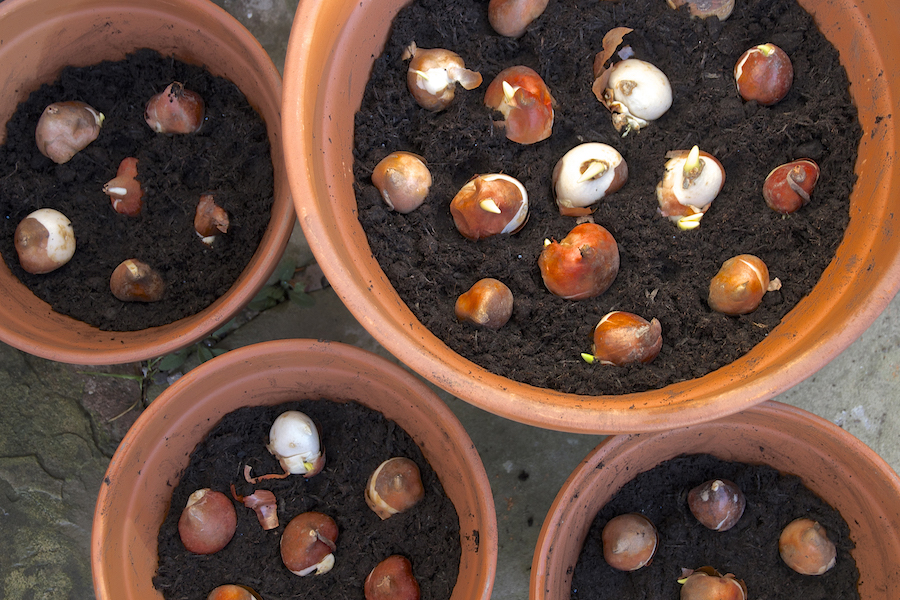Preparing to plant your new spring bulbs? 7 colourful options to consider
Summer’s on its way out, which means it’s time to start planting your new spring bulbs – and why not turn over a new leaf and try something different? Bulb specialists and other outlets have a host of options to create a riot of colour in spring, or you could opt for some more unusual eye-catching varieties.
Here are some of the new and unusual spring bulbs to consider…
1. Fritillaria persica Purple Dynamite, £12.50 for one, Directbulbs.co.uk

This deep purple fritillaria looks good with cream contrasts (Direct Bulbs/PA)
This new hybrid of the persica family has wonderful shiny flowers of a deep purple black, and grows to 60-90cm (2-3ft). It’s ideal for free-draining sunny borders and looks stunning grown alongside Fritillaria Persica Ivory Bells, as the creamy white flowers are such a great contrast. Left to naturalise, it will work well planted with eremurus.
2. Iris Germanica ‘Bumblebee Deelite’, £6.99 for three bare roots, Dobies

This bearded iris ‘Bumblebee Deelite’ packs a colourful punch (Dobies/PA)
This pretty miniature bearded iris bears dainty yellow and purple flowers, producing up to five flowers per stem. Grow it in full sun in well-drained soil and fertilise the soil every spring, as these little plants are hungry feeders.
3. Tulipa clusiana ‘Tinka’, £5.40 for 10, Broadleighbulbs.co.uk

Tulipa ‘Tinka’ (Broadleigh Bulbs/PA)
The elegant Tulip clusiana cultivars are sometimes overlooked but make easy plants for a sunny bed or rock garden, or in a pot. They may also thrive without being lifted. ‘Tinka and ‘Honky Tonk’ are two of the newest and among the best. ‘Tinka’ is an eye-catching addition to a sunny rock garden, bearing slender flowers of pure yellow with deep red outer petals. As the plant ages it develops an apricot hue.
4. Narcissus ‘Snowy Mountain’, £5.50 for eight bulbs, Tulipstore.eu/en

Narcissus ‘Snowy Mountain’ (Tulip Store/PA)
This new daffodil recently received a five-star rating from Which? Gardening, the Consumers’ Association magazine. It reported that this statuesque variety has grey-green leaves and stems which complement the large white flowers very well, creating a cool colour combination. The stems stayed strong and straight when the flowers were open, and the large blooms had impressively long trumpets, blooming for around four weeks.
There are so many daffodils on the market, I can’t just feature one – so you may want to check out N ‘Frosty Snow’, a lovely new large cupped variety that has snow white flowers with a soft lemon cup that matures to white with a rim of pale yellow. It looks superb grown with Narcissi ‘Avalon’ or ‘Accent’ and sits well either in the border or in containers. Feed with bonemeal or tomato food during the leaf and flower stage to ensure years of colour.

Narcissus ‘Double Joy’ (Direct Bulbs/PA)
If you want a dwarf variety that packs a punch, look out for N ‘Double Joy’, the double form of the old favourite ‘Jetfire’, which is ideal growing in containers or at the front of borders (both available from Directbulbs.co.uk). While for a cool white type, try ‘Polar Ice’, available from Dobies.
5. Eranthis hyemalis ‘Pauline’, £10 for one, Directbulbs.co.uk

Eranthis hyemalis ‘Pauline’ (Direct Bulbs/PA)
This rare winter aconite is pale lemon, with delicate flowers surrounded by deep green leaves. Plant it in the shady areas of the garden alongside snowdrops or chionodoxa for a dazzling display early in the spring. It should naturalise well and as such come back year after year.
6. Gold Waxed Amaryllis, £11.99 for one bulb, Unwins.co.uk

Bring a touch of gold to your table with this gold waxed amaryllis (Unwins/PA)
This huge bulb arrives in a golden waxed coating, so no plant pot is needed to add sparkle to your houseplant. Start the bulb off in September indoors and by Christmas you should have a large, deep red amaryllis (hippeastrum).
From one bulb at least one large, tall stem will emerge, which may branch and form several saucer-size blooms, just in time for the festive season. Flowers continue for weeks for a welcome, long display into January.
7. Tulipa ‘Brownie’, from £6.30 for 10, Avonbulbs.co.uk

Tulipa ‘Brownie’ (Avon Bulbs/PA)
The rich copper hues of this unusual double tulip makes it one to include in the list. It is short stemmed, which helps stop it flopping when the heads become heavy in the rain, and does best in full sun, although try to avoid windy spots. Don’t plant these bulbs until late October or early November, when frost should have reduced the level of disease in the soil.
The Press Association
Latest posts by The Press Association (see all)
- 5 new books to read this week - November 23, 2024
- 3 easy Mary Berry recipes to make this season - November 22, 2024
- In Pictures: Party stalwart kept New Labour in touch with traditional supporters - November 21, 2024
- 6 easy indoor exercises to try this winter – and why they are good for you - November 19, 2024
- Martin Clunes: I can’t afford to retire – I’ve got too many horses - November 19, 2024





















